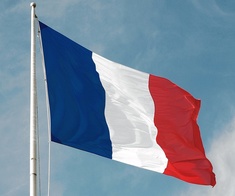
Five Islands of France.
First published: Saturday February 5th, 2022
Report this blog
Introduction.
Following the success of my blogs about the smaller, relatively unknown, islands of the United Kingdom and Ireland, I thought it would be a good idea to write some blogs about islands of different countries. So as not to bore everyone too much, and to make sure I have pictures and some historical facts, I decided to limit each blog to five islands.
I have chosen five islands around the coast of France for my first effort. These are obviously not the well known islands, such as Corsica and Mont St.Michel. Those examples have a plethora of history, too much for a small blog, and they are probably already known about anyway. No, my intention with these blogs is to inform and amaze......maybe !
I shall endeavour to publish a new blog every couple of weeks or so, each about five islands from one country, so if you have any suggestions, then please let me know in the comments.
Now, off we jolly well go to the first of five....
Chausey.
Geographically, Chausey is a part of the Channel Islands. However, unlike the rest of the group it is under French control and therefore rarely mentioned in the same conversation. There are no direct links between the English Channel Islands and Chausey, although you could probably ask a friendly boat owner to give you a lift there!
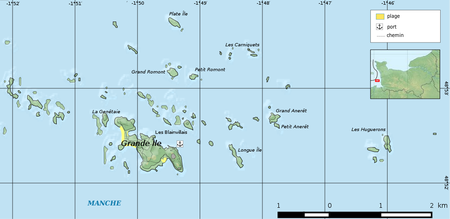
The French make claims that Chausey is the largest archipelago in Europe, although only at low tide. At High tide there are around 52 islands, but this increases several fold when the water recedes to about 365 islands and islets due to one of the highest tidal ranges on the continent.
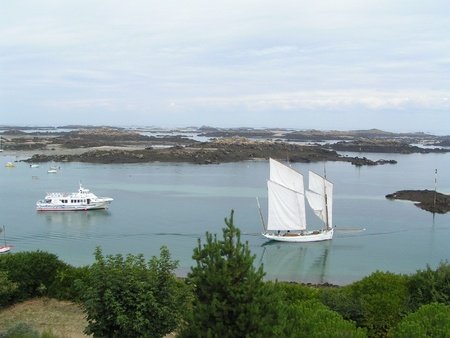
The islands have changed ownership many times over the centuries, switching between England and France as wars and battles were fought. The monks of Mont St.Michel built a priory on the largest island, Grande Ile, in 1022 and the islands were under the jurisdiction of Jersey until 1499, when they were handed over to the French. The Sound between the islands, pictured opposite, was a secluded haven for smugglers and pirates for many years.
The present fort is the third such building to be constructed, the previous two being destroyed by the English. Napoleon III ordered the construction of the current fort in 1859. It was completed in 1866 and served briefly as a prison for the local community on the mainland. During the First World War it served again as a prison for German and Austrian POWs. During the Second World War it was an occupied German garrison.
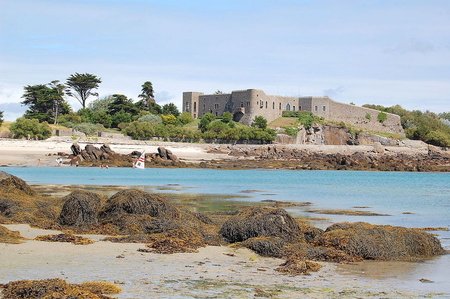
Between the two World wars, the castle was purchased by Louis Renault of car making fame, and used as a retreat from the pressures of business.. Nowadays it is, in parts, home to several fishing families.
Grande Ile is the only inhabited island of the group with a population of around 30 in the winter months. However the island has almost 200,000 annual visitors during the warmer months.
The islands can be reached by ferry from either Granville or St. Malo.
The islands website has many pictures in it's gallery.
Île de Sein
The Île de Sein is a Breton island lying eight kilometres or 5 miles off the coast of Finistere in the extreme west of Brittany. It is surrounded by treacherous seas that require many lighthouses due to its proximity to main shipping lanes in the English Channel, or should I say La Manche !

There is evidence of habitation on the island dating back to the Bronze Age. Two menhirs, or standing stones, known as the "gossips" are near to the local church, so called because of their resemblence to two people gossiping. The island was also known to the Romans during their occupation of the area.
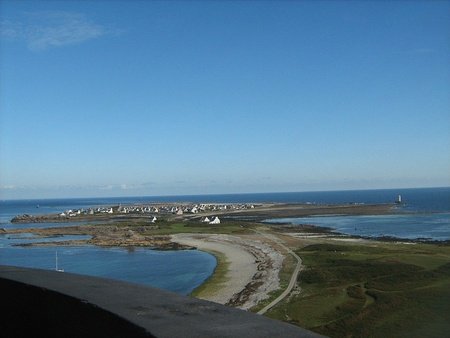
The women of the island, according to legend, used to wear black headdresses and lure sailors onto the rocks by witchcraft. The islands were also known for it's "wreckers" that lit false lights to cause shipwrecks.
During World War II, the islands were occupied by the Germans who destroyed the lighthouse that was built in 1839. It was rebuilt in 1952.
After hearing a broadcast by Charles de Gaulle calling for resistance against the German occupation, all of the male inhabitants over the age of 14 set sail in a fishing boat, the Corbeau des Mers, to join the Free French in London. For this act of bravery the entire community was awarded the Order of the Liberation by the French government in 1946. On the 18th June each year there is a celebration commemorating this event.
According to Breton legend, Île de Sein was home to druid virgin priestesses called Gallizenae who had the power to predict the future, calm winds, and take the form of many animals.
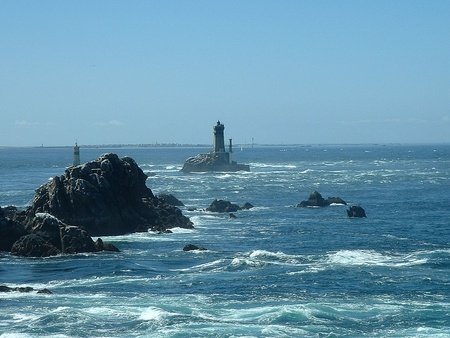
The island can be reached by boat from Audierne or Brest depending on the season, the crossing takes about an hour in good weather.
The islands website has many more views and information.
Île-d'Aix
The Île-d'Aix is a little over one square kilometre (or just less than half a square mile) in size and is situated at the mouth of the River Charente on France's west coast.
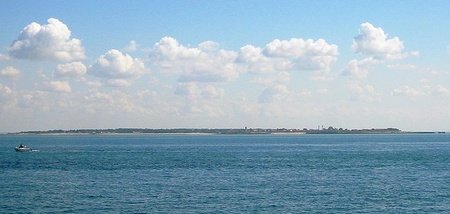
Until around the year 1500, this island was a tidal island that was connected to the mainland at low tide. A small convent was established in 1067 and in the 12th century the island was fought over by the French and English.
It came under English control during the Hundred Years War, and during the Seven Years War changed hands several times. It was also the location of the Battle of the Basque Roads during Napoleonic times in 1809, a year after Napoleon visited the island and ordered an increase in defences.
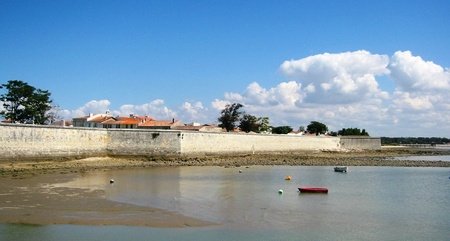
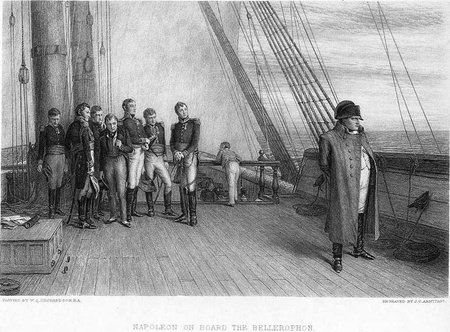
In 1815, following his defeat at the Battle of Waterloo, Napoleon spent his last days in France on the island, in an attempt to evade capture in the naval blockade. When he realised the futility of his plan, he surrendered to the British monarchy and was transported on HMS Bellerophon to Plymouth, prior to his transfer to St.Helena.
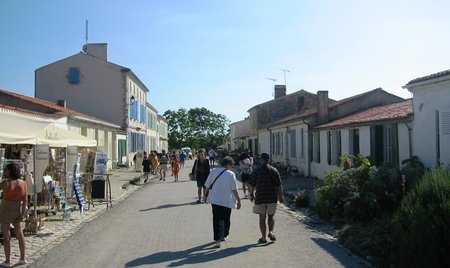
Nowadays, the island is popular for day trips and can be reached via ferry from Fouras year round. Alternative ferries sail from La Rochelle and Oleron during the summer months. No cars are allowed on the island except for emergency and service vehicles. Transport is mainly by foot, bicycle, or horse drawn carriage.
The island has it's own website run by the town council.
Île du Levant
Another island, another coastline. We have moved from the wilds of the Atlantic shores to the calm of the Mediterranean Sea. Île du Levant, or simply Le Levant is a small island off the coast of the French Riviera near Toulon.
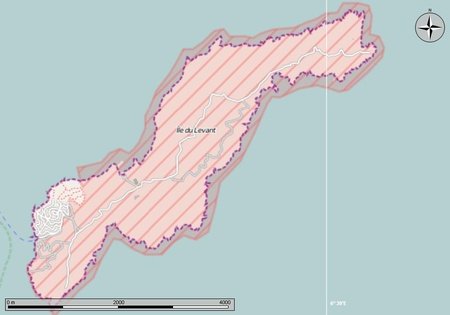
This island is a little bit different in that parts of it are off limits to tourists (shaded areas in the picture above), whereas the other areas are privately owned by a tourist company specialising in Naturist holidays.
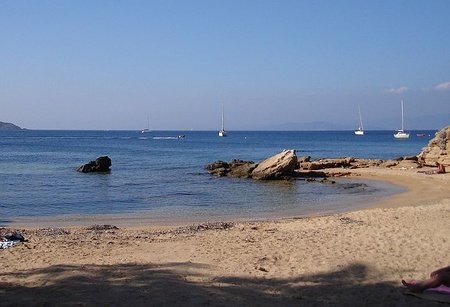
There is evidence of habitation dating back to the Bronze Age, although there appears to be times when the island was left alone. It was considered part of the Greek colony of Massalia, an area now known as Marseille.
The ruins of a 15th century monastery still exist, and the island was used as a prison for young offenders and orphans in the 19th century. A plaque commemorating the death of 89 inmates is situated in the military part of the island.
In 1931, two brothers, Andre and Gaston Durville, both of whom were doctors, established Europes first naturist village called Heliopolis. Being nude is allowed in all parts of the village, obligatory on the beaches, except in the harbour area. Here it is expected to wear what the French call le minimum. Basically just a g-string covering certain areas of the body. This is not overly policed or enforced !
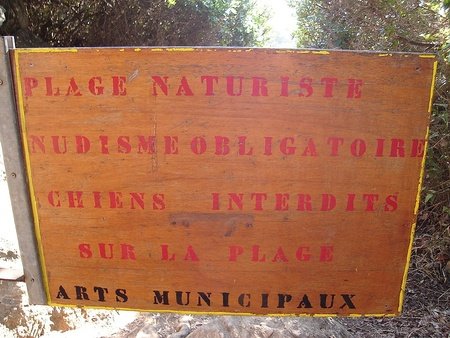
If you want to, the island can be reached by passenger ferry, no cars allowed, from Hyeres or Le Lavandou
An extremely comprehensive history of the island can be found on this website. (Please be aware that the gallery on this website contains some images that may not be safe for work)
Île Sainte-Marguerite.
Île Sainte-Marguerite is the largest of the Lerins Islands situated off the Mediterranean coast near to the resort town of Cannes. The island is heavily forested with umberella pines and eucalyptus trees.
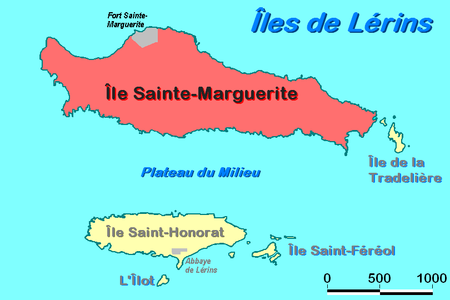
The island is known to have been inhabited prior to the Roman occupation when it was called Lero.
It became home to an order of monks from the 5th century for around a thousand years.

In 1612, the island's ownership passed from the monks to the French nobility and Fort Royal was constructed. Spain invaded the islands during the Thirty Year War and took possession for a couple of years until it was recaptured.
The fort was then strengthened and it became a garrison and prison. The jail has housed some famous prisoners including Algerian rebel leaders and the mysterious "Man in the Iron Mask"
This particular prisoner's identity has never been revealed but there are numerous theories. The most widely accepted hypothesis is that he was the illegitimate brother of Louis XIV. Whoever he was, he has spurned a large tourist trade around his legend.
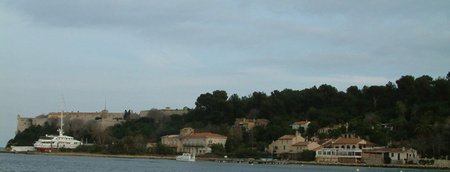
The village on the island consists of around twenty fishermens homes, along with a few tourist shops and cafes. The former fort and prison is now a museum with exhibits that include the original cells. There are also memorials to the French soldiers that died on the island during their convalescence after the Crimean War.
The island can be reached by a regular ferry service from Cannes that is operated all year round.
The town of Cannes has a section in their website dedicated to the island.
Summary
Five from France. I hope you enjoyed them. As I said in the Introduction, I will be making a few of these blogs, I find islands fascinating so I am really enjoying writing and researching these articles.
I just like to take the opportunity to thank Ethaboo and ChineseChen for continuing to include my blogs in their Games series. This isn't a grovelling comment, but I really think that they are helping to increase the quality of the Recent User Blogs. I take more care with proof reading than I ever did before, and try to make my blogs more interesting, all in search of that illusive top spot !
So, anyway, where's next on the island expedition. My next entry will be about a country that isn't well known for islands, and It has a relatively short coastline compared to other nations. My next blog in this series will be about the islands of ............ Germany.
I will also consider any suggestions for future island blogs, or indeed any improvements you think I could make to my blogs in general.
Here's to the next time my fellow blog addicts of JetPunk. (I remembered the capital P that time.)

I love the continuation you made!
I didn't know at all Sainte-Marguerite and Sein, so I thank you for making me discovering these two cities and their History.
When I was in Saint-Malo, I wanted to visit Grand-Ile, but it was not during the summer, with many tourists, so there were less ferries than indicated in our travel book and we sadly weren't able to join the island with my family... But I learnt a lot about it in Saint-Malo, and this blog was a good complement for me.
The Île-d'Aix was the one I knew the most in this blog, because I saw many documentaries about Napoléon, and it's of course often mentioned. You did a great resume here.
Finally, I knew Île du Levant just by name and some facts, so this blog was a way for me to learn more about it.
I missed the first numero about the United Kingdom, but I now want to read it. Good job, once again! Please, continue blogging. I can't know if the Blog Games help to improve the quality of RUB, but you sure do it yourself.
I told youMany of these islands have two lives, their winter life is very different from their summer one. Although this is probably the same throughout the world.
Germany is in pre-production research at the moment.
I know you did MG, luckily he liked it, lol
To answer your question, Mont St.Michel is known as a "tidal island". So basically a part-time island if you like. It is very much similar to its Cornish counterpart St. Micheals Mount.
I didn't include it in this blog because it is too well known.